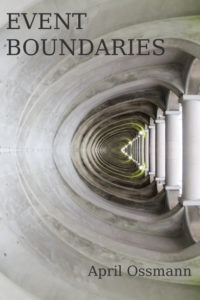April Ossmann is Kate’s next Guest Writer–joining us on April 22 at 1:30 p.m. at Kate’s J Street writing loft in Sacramento!
Come to this free reading, Q&A and potluck book signing reception (bring your book money!). R.S.V.P to kate (at) kateasche (dot) com to receive address and parking information. Folks with first name with starting letter A-M please bring a snack to share, N-Z a beverage to share; servings for 6-8 will be great. (Can’t make it on April 22? Have no fear–you can catch April at Sacramento Poetry Center’s regular Monday readings on April 24. Doors open at 7:00 p.m. for reading at 7:30 p.m. at 25th and R Streets in Midtown Sacramento.)
This interview is Part II in a two-part series presented in conjunction with SPC’s Poetry Now. This part focuses on craft. To read Part I, in which Kate talks with April about her new poetry collection, visit Poetry Now.
April Ossmann is the author of Event Boundaries (Four Way Books, 2017), and Anxious Music (FWB), recipient of a 2013 Vermont Arts Council Creation Grant, and former executive director of Alice James Books. She is an independent editor (poetry, essays, reviews) and a faculty editor for the low-residency MFA in Creative Writing Program at Sierra Nevada College. Learn more at www.aprilossmann.com.
Q: How long have you actively been working with Event Boundaries as a collection? How many drafts has the book gone through as a whole? What poem(s) in the book went through the most drafts individually, and how many were those?
A: For the eight years between signing the book contract for Anxious Music and submitting the manuscript for Event Boundaries, I was writing new poems toward my second, as-yet-to-be-firmly-titled, second collection, but I also included earlier poems which fit thematically and stylistically with Event Boundaries. “Stubborn” fit thematically, but not stylistically, because I wrote it so long ago that my style had changed. I revised and revised until it fit…I’m not sure how many drafts it went through, but I’d guess at least twenty, as I worked to tighten and pare the language to match my current, more streamlined idiom.
I’d guess that I took the manuscript as a whole through around ten drafts, with increasingly minor revisions as I progressed. Before I submitted the manuscript for consideration at Four Way Books, I asked Kevin Goodan, a good friend and colleague, for criticism, and revised accordingly. I revised again, after receiving editorial suggestions from my editor and publisher, Martha Rhodes. They are both wonderful editors and poets, and I remain grateful for their assistance.
Q: “Scrim” and “Venture” make a lovely progression, in which “Scrim” comments on the speaker’s desire for wit [“All I ask of wit / is that it stand / between me and mystery, / not like a guard or armor, / more like a screen / against bites and stings”] and then “Venture” enacts the very kind of wit I imagine the speaker desires. This is just one of several mini-series of poems I found within the collection. What techniques for ordering the poems worked best for you as you assembled this particular collection?
A: I talked in the first half of this interview at SPC’s Poetry Now about ordering the poems to reflect my spiritual and emotional growth. I also ordered to interweave subjects, connecting them via shared themes, images, counter-point, argument, evolution―and undermining. When I placed a poem that spoke to a form of certainty, I often followed it with one which undermined it with a form of uncertainty. Following “Scrim” with “Venture,” does the opposite, offering comfort after an abyss―followed by “Stubborn,” which makes fun of surety, followed by…“The Doubt House!”
Q: I’m sure there are certain pieces of advice that you give to writers over and over again. What are some of these? Which of these were hardest for you to follow as you worked on this collection? Why were they hardest, and how did you (did you?) ultimately find a way through?
A: Try to eliminate prosiness and improve music by trimming clutter (unnecessary articles, conjunctions, and prepositions); try heightening language, dramatic tension and music, by eliminating unnecessary stage and time direction and explanations, and substituting active verbs for forms of the verb to be. None of this advice is hard for me to follow now in general, but an older poem, “Stubborn,” was challenging to revise, in part because of my emotional attachment to it, which can blind (and deafen) poets to a poem’s weaknesses. You might say the approach I used to solve this was stubbornness! I spent a couple of months revising the poem, but limited myself to short sessions (a few minutes to an hour), waiting a few days to revise again, until it finally fit my current, more streamlined mode. For example, the poem opening went from,
“I knew it would be harder what with
the blizzard and all, but didn’t think about it.
You can’t, if you’re going to do a thing. Where”;
to,
“I know it’ll be hard after the blizzard,
but don’t ponder it. You can’t
if you plan to act. Where would”
Q: What new (to you) craft concept or skill did you encounter/develop as you worked on this collection?
A: I wrote many of the poems during my first five years of editing poetry full-time. I discovered, on my first-ever writing retreat, that my first drafts read like my fifth or sixth drafts once did, thanks to that work. If you practice something constantly, you’re bound to get better at it! The most fun craft concept I tried was writing the golden shovel poems, “Celestial Solo, or Divine Funk?” and “Mars Rising.” I highly recommend the form, it’s inspiring, and seems to create direct access to the unconscious contributions I prize.
Q: Could you explain the “golden shovel” form?
A: The form was invented by Terrance Hayes, with his poem, “The Golden Shovel” (Lighthead, Penguin Books, 2010), an homage to Gwendolyn Brooks, which borrows her poem “We Real Cool,” in its entirety and incorporates it in the new poem. To write a “Golden Shovel” poem, find a short poem by Gwendolyn Brooks (or any poet) and lay it out vertically on the right margin of the page, so that the last word of each line in the new poem is the next word of the quoted poem (be sure to credit the poet). I used a variation of the form for my poems, borrowing a line from a Gwendolyn Brooks poem, and placing the borrowed line vertically on the right margin of the poem, so that the last word of each line in the my poem is the next word of Brooks’ quoted line.
Q: What has your work with this collection taught you about yourself as a person?
A: I learned to follow my advice to poets: keep the faith, and when you can’t, persist as if you still have it when you feel doubt about your skills or getting published.
Q: What has been the best thing to come out of the publication of Event Boundaries thus far? This can be a writing thing, a life thing…what has meant the most to you? Or maybe, what has surprised you most?
A: So far, the best thing about publishing Event Boundaries is the opportunity to honor my brother in a public and “permanent” way. I discovered, in an internet search for his name, that the only result was his obituary, which added to my grief. Now, for however far into the future people read the book, his having lived will continue to affect readers.
Q: In what way(s) does this collection still feel unfinished or unrealized to you? To put it another way: What haunts you from its pages?
A: I have two very different answers to those two questions. What feels unfinished is my spiritual growth, an ongoing process I expect all my future poems will nurture. What haunts me in the book is my brother’s early death. Writing those poems helped me to navigate my grieving, and reading/sharing them does as well, but I have yet to learn not to regret my―and his―loss.
Q: Are you working on a third collection? If yes, is there anything you feel comfortable sharing about it? If no, what is on your desk these days that we can look forward to reading?
A: I’m happy to say I am well into my work on a third collection, whose subjects and themes include prejudice/acceptance, judgment/compassion, and personal responsibility/accountability. In 2017, there seems to be an exponential number of possible causes to champion, and while I’m concerned about many, I find myself most absorbed by how to address prejudice in our society, beginning with self-examination. I was first moved to write about it by news stories of racial prejudice in policing and judicial practices, but I’m considering many kinds, not limited to gender, sexuality, political affiliation and class prejudice…I hope to learn where I most need to evolve, and how to set a better example.
∞

